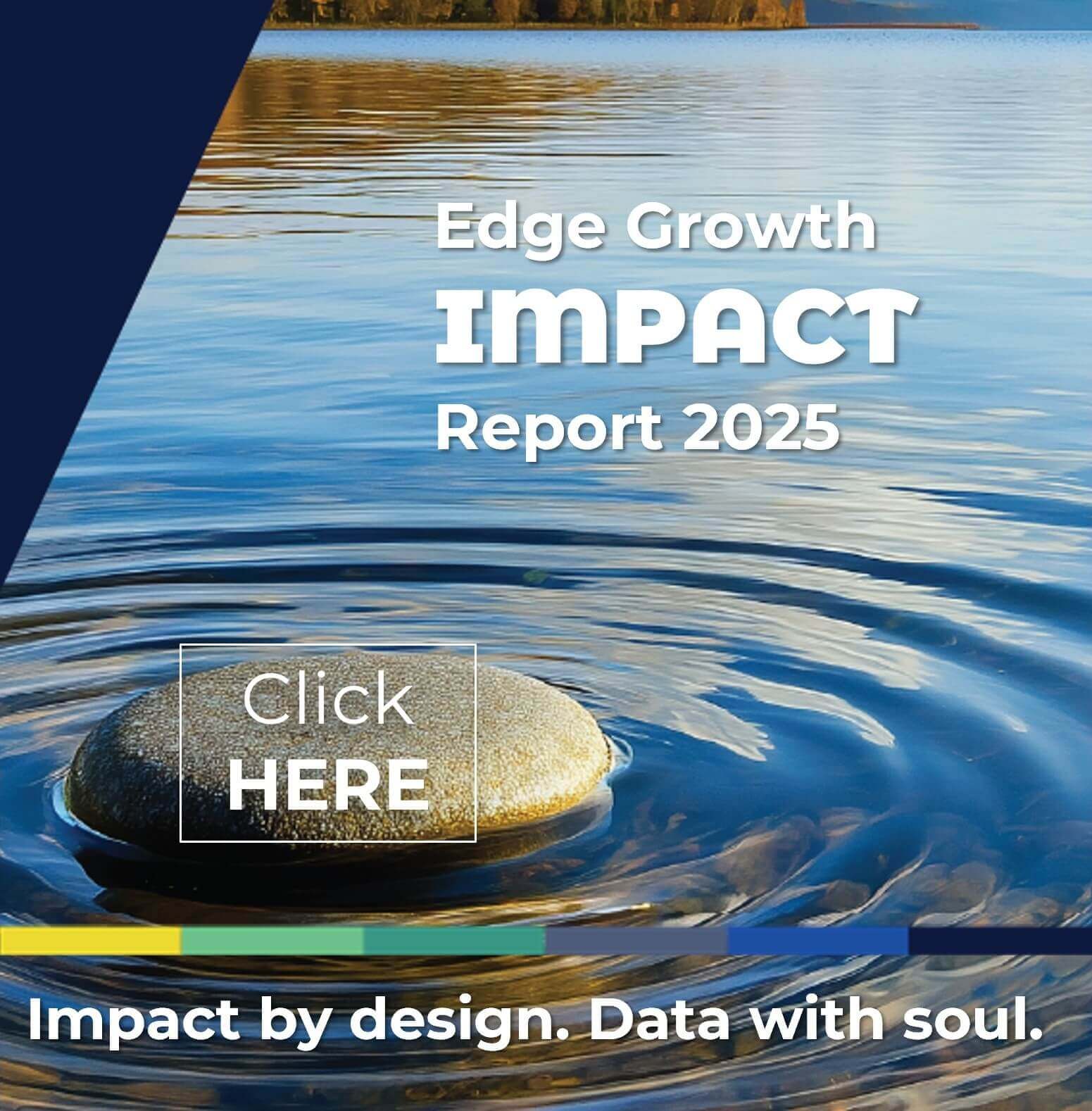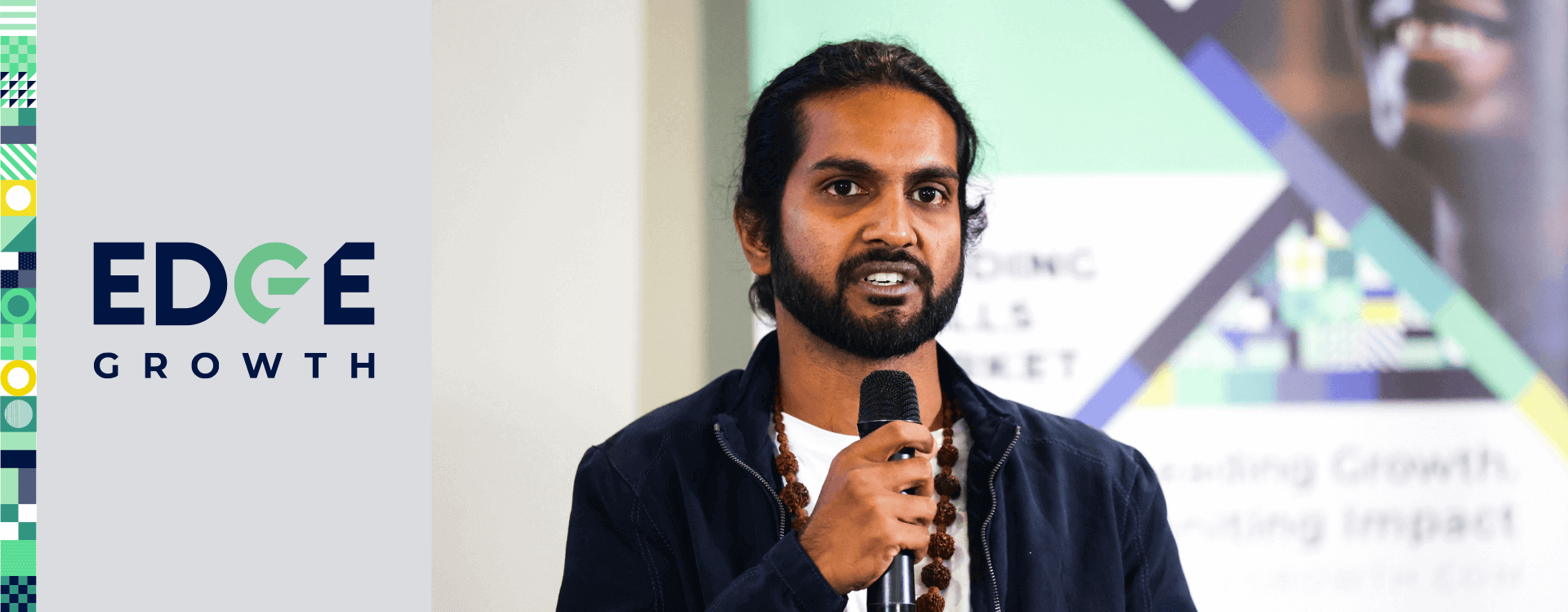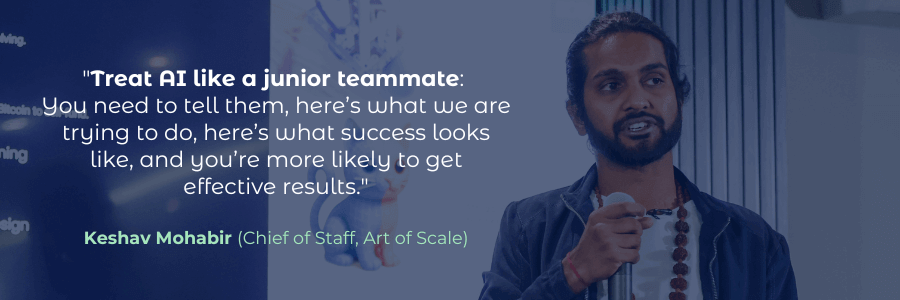
Despite significant investments in AI tools, most business owners are struggling to generate meaningful returns from their spend on these technologies. While many founders utilise AI for tasks such as market research, copywriting, and reporting, these tools often fail to deliver the specific insights needed about their customer base due to the lack of detailed context and inputs these platforms require.
This gap between AI’s promise and practical outcomes has left many questioning the efficacy of their approach and the quality of the tools they’re using.
The disconnect stems from business leaders approaching AI like a search engine such as Google and expecting immediate, resourceful responses, when in fact, the most effective approach requires treating AI more like a “𝐭𝐞𝐚𝐦 𝐦𝐞𝐦𝐛𝐞𝐫 𝐰𝐡𝐨 𝐧𝐞𝐞𝐝𝐬 𝐜𝐥𝐞𝐚𝐫 𝐝𝐢𝐫𝐞𝐜𝐭𝐢𝐨𝐧,” as AI enthusiast Keshav Mohabir explains.
At Edge Growth’s recent Investee Day, Keshav Mohabir, Chief of Staff at Art of Scale, demonstrated how progressive leaders can achieve superior outcomes by developing a deeper understanding of how to effectively implement AI into their daily business operations.
Here are 4 proven strategies that can transform AI from a disappointing experiment into your greatest business asset: ⬇️
1. Approach AI Like a Junior Teammate Who Needs Clear Direction
You’re likely approaching AI with unrealistic expectations about what it can and cannot deliver right out of the box. Most business leaders give vague, broad prompts such as “create a marketing plan” and expect a detailed strategy that will transform their operations. But as Keshav discovered, “𝐁𝐚𝐝 𝐩𝐫𝐨𝐦𝐩𝐭𝐬 𝐭𝐞𝐧𝐝 𝐭𝐨 𝐛𝐞 𝐯𝐞𝐫𝐲 𝐠𝐞𝐧𝐞𝐫𝐚𝐥, 𝐯𝐞𝐫𝐲 𝐛𝐫𝐨𝐚𝐝, 𝐚𝐧𝐝 𝐧𝐨𝐭 𝐭𝐨 𝐡𝐚𝐯𝐞 𝐚 𝐜𝐥𝐞𝐚𝐫 𝐨𝐮𝐭𝐜𝐨𝐦𝐞 𝐭𝐡𝐚𝐭 𝐲𝐨𝐮’𝐫𝐞 𝐥𝐨𝐨𝐤𝐢𝐧𝐠 𝐟𝐨𝐫.”
Think of it like hiring a brilliant graduate with impressive credentials but zero experience in your industry. If you tell them to “handle marketing,” you’ll get generic, directionless work. But give them specific client profiles, clear objectives, and detailed context about your business, and they’ll deliver focused results that actually move your bottom line.
AI works the same way. It has access to a plethora of knowledge, but it knows nothing about your customers, your market position, or your specific challenges. Feed it strategic, detailed direction about your business, and it transforms from producing generic fluff to delivering solutions tailored to your actual needs.
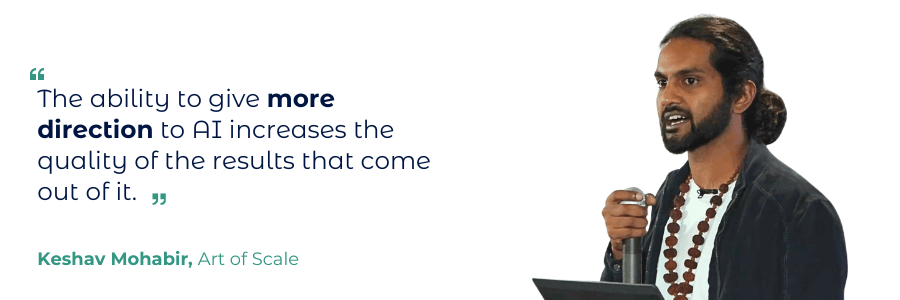
How to improve your communication with AI:
🔵 Eliminate guesswork by providing specific and clear direction.
🔵 Treat AI communication as a project briefing.
🔵 Establish your target outcome before beginning.
𝐎𝐮𝐭𝐜𝐨𝐦𝐞: When you manage AI properly and replace the assumption-based interactions with clarity and detail, it will transform from an unpredictable resource into a valuable business tool.
2. Let AI Guide the Conversation
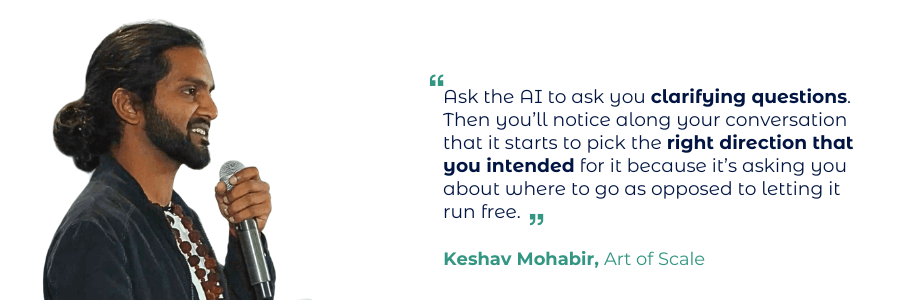
Imagine AI as your most experienced consultant who will equip and strategise your desired operational outcome. Instead of relying on its basics, direct AI to analyse your specific business requirements. This approach establishes a structured dialogue. It facilitates a deeper understanding of your business operations and refines your solutions.
How to transform AI into your thinking partner:
✔️Direct AI to seek clarification through targeted questions rather than proceeding with assumptions. ✔️Answer the questions thoughtfully and provide comprehensive context. ✔️Observe how AI delivers more focused and relevant solutions.
𝐄𝐱𝐚𝐦𝐩𝐥𝐞: Instead of asking “help with social media posts,” give AI your complete brand personality document and specify: “Create X number of LinkedIn posts that align with our brand voice for our Q4 SaaS launch, targeting series A tech startups with 20-50 employees.” Then, dive deeper by sharing your content requirements, successful post examples, and drafts you’ve already created. **AI will generate content that matches your brand identity while building on your existing work.
𝐑𝐞𝐦𝐞𝐦𝐛𝐞𝐫: AI is designed to enhance and refine what you provide, not create everything from scratch. You are the primary thinker and strategist.
3. Deploy AI for Operations So You Can Focus on Strategy and Growth
Using AI as a strategic partner, Keshav developed a beach 🏖️ ranking application in just 3 days that analyses water quality, weather conditions, and user reviews. He also built a wildfire tracking system within 1 week. Both of these projects would typically take months to execute within traditional development teams.
But here’s where it gets even more powerful: AI agents. These autonomous systems work in the background with minimal oversight, unlike standard AI tools that need constant prompting and direction.
Think of them as your most reliable employees who never take breaks and execute complete workflows without hand-holding.
These agents tackle your most time-consuming operational tasks, from developing entire social media campaigns to automatically processing timesheets into invoiced billing. This frees you up to focus on what actually grows your business: strategy, partnerships, and scaling operations.
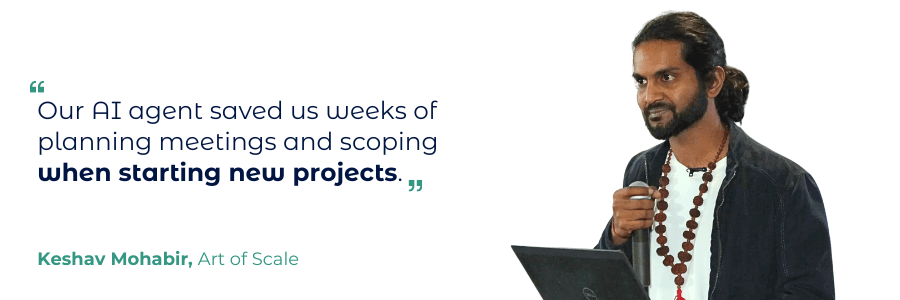
This approach focuses on enhancing operational tasks rather than replacing employees. It enables you as a business leader to eliminate manual and repetitive tasks.
Steps to successfully implement these AI principles:
⚪ Identify your most time-consuming manual processes.
⚪ Direct AI to automate data collection and analysis.
⚪ Concentrate on leadership efforts such as strategic planning and outcomes to scale your business.
𝐎𝐮𝐭𝐜𝐨𝐦𝐞: When you delegate operational tasks to AI, you create capacity to focus on scaling your business rather than simply managing day-to-day operations.
4. Build AI Skills Through Personal Experience and Application
Most business leaders face challenges with AI as they attempt to achieve business results first without understanding its fundamentals. The key is starting with personal applications – whether using AI for meal planning within a specific diet and budget, or, as in Keshav’s experience, turning to it during a critical medical emergency.
When Keshav’s wife went into labour at home, unexpected complications arose that completely changed their birth plan. Rather than letting uncertainty overwhelm him, Keshav turned to AI for medical research that helped him make informed decisions during an extremely stressful situation.
He provided the AI with comprehensive context about their situation, including specific details about timelines, C-section procedures, and potential emergency scenarios. When doctors indicated that an emergency C-section was necessary and warned that the baby might not be breathing at delivery, Keshav was mentally prepared.
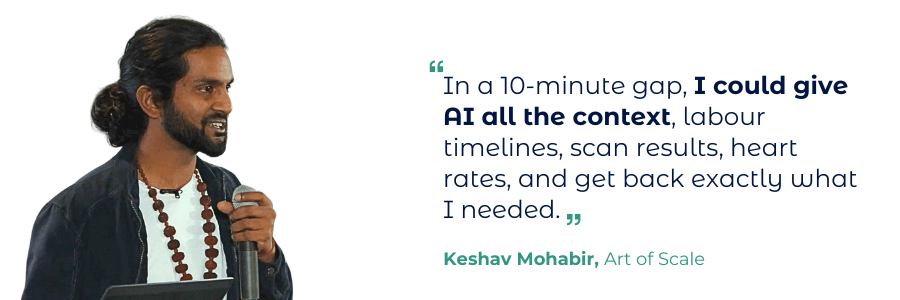
When his baby (Krishna X) was born without breathing, the medical team responded immediately. Because Keshav had researched these exact scenarios beforehand using AI, he remained calm and composed while supporting his wife through the crisis. Krishna X was born healthy, and Keshav credits AI with helping him stay focused when it mattered most.
This personal application (although unusual), taught Keshav how to communicate effectively with AI under pressure, a skill that directly translated to his professional success. By mastering AI in high-stakes, real-world situations, he learned to extract accurate, actionable information quickly.
How to develop your AI skills through personal experience
➡️ Use AI to research personal interests or solve daily challenges.
➡️ Practice giving context and asking specific questions.
➡️ Learn effective approaches through low-stakes experimentation.
➡️ Apply those communication skills to business challenges.
When AI patterns are understood through personal experience, business leaders can strategically direct these systems for business results. The communication skills Keshav gained through navigating a medical emergency are identical to those that assisted him in developing apps within a matter of days and automating business processes.
Keshav’s journey from startup founder to AI implementation expert demonstrates that technology alone does not determine successful business outcomes. It is how you, as a business leader, apply it.
The gap between business owners who extract real value from AI and those who waste their investment isn’t about technical expertise but about leadership. Just as you wouldn’t expect a new employee to deliver exceptional work without proper direction, AI needs the same management approach you’d use with your best team members.
𝐑𝐞𝐦𝐞𝐦𝐛𝐞𝐫: Your results will only be as good as the clarity of your instructions. Master this fundamental principle, and AI becomes your most productive asset. Ignore it, and you’ll join the ranks of owners wondering why their expensive AI tools aren’t moving the needle.
💭 𝐐𝐮𝐞𝐬𝐭𝐢𝐨𝐧: What repetitive tasks in your business could you delegate to AI this week? What context does your AI require to understand your business?
🟢 𝐅𝐨𝐫 𝐦𝐨𝐫𝐞 𝐀𝐈 𝐢𝐦𝐩𝐥𝐞𝐦𝐞𝐧𝐭𝐚𝐭𝐢𝐨𝐧 𝐬𝐭𝐫𝐚𝐭𝐞𝐠𝐢𝐞𝐬, watch Keshav’s full talk from Edge Growth’s Investee Day on YouTube 👉 https://tinyurl.com/KeshInvestee
🟢 Access tools and resources for your business growth on our SME Hub 👉 https://tinyurl.com/yhdjt5rx
Event Host: Daniel Hatfield (CEO of Edge Growth) Featured Speaker: Keshav Mohabir (Chief of Staff at Art of Scale, Founder of Cat Design)

